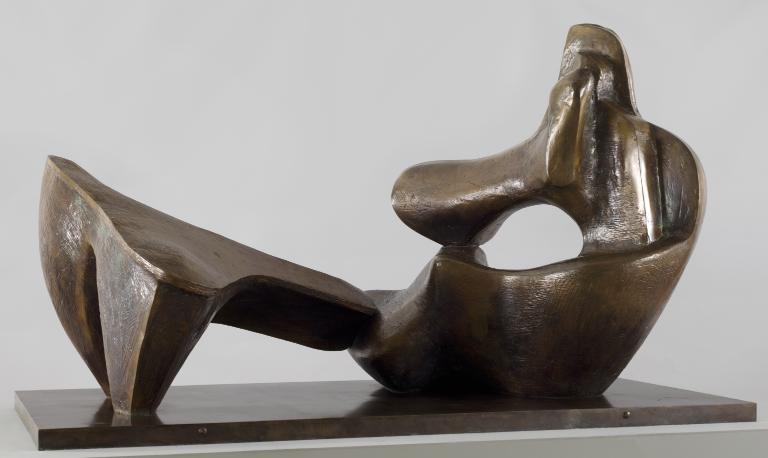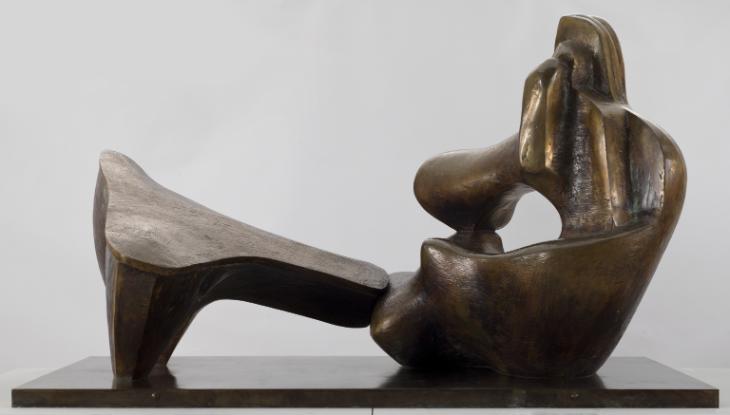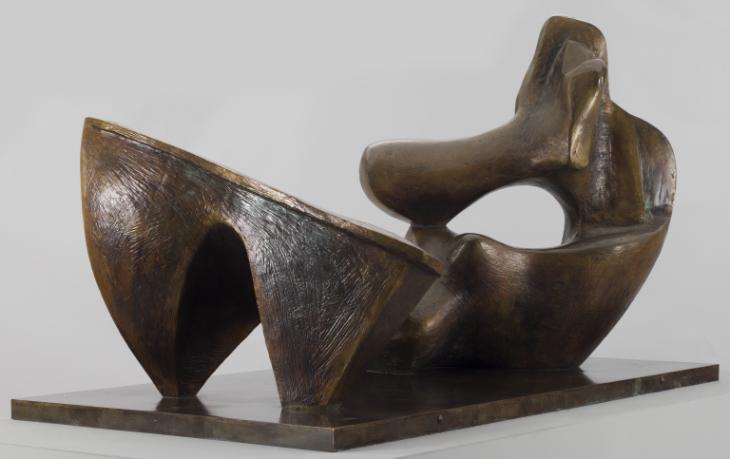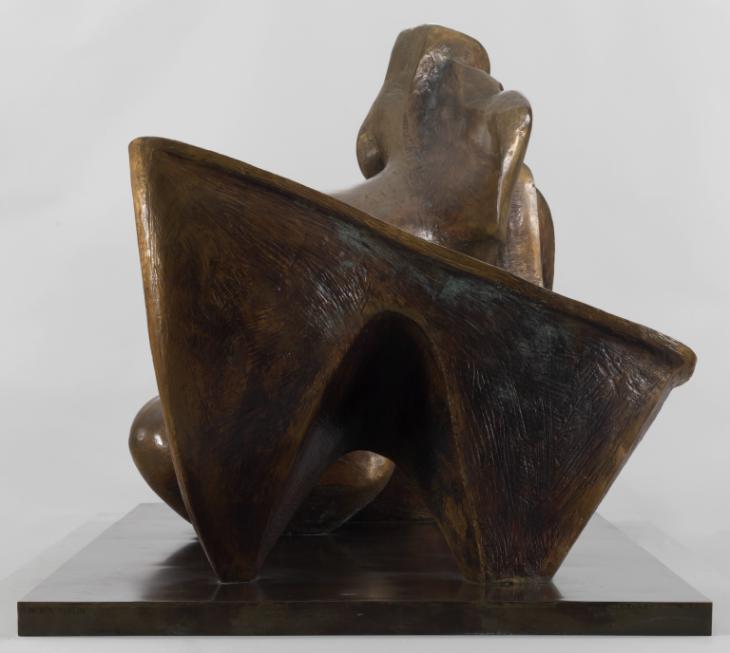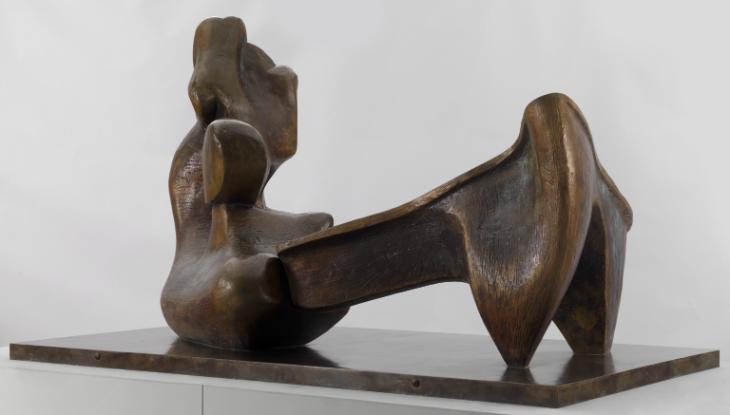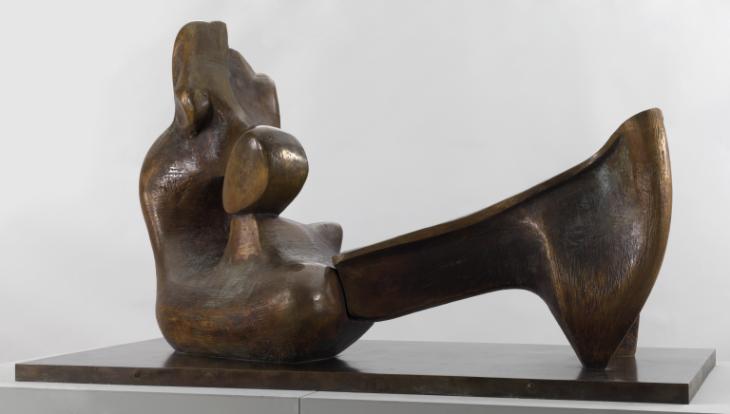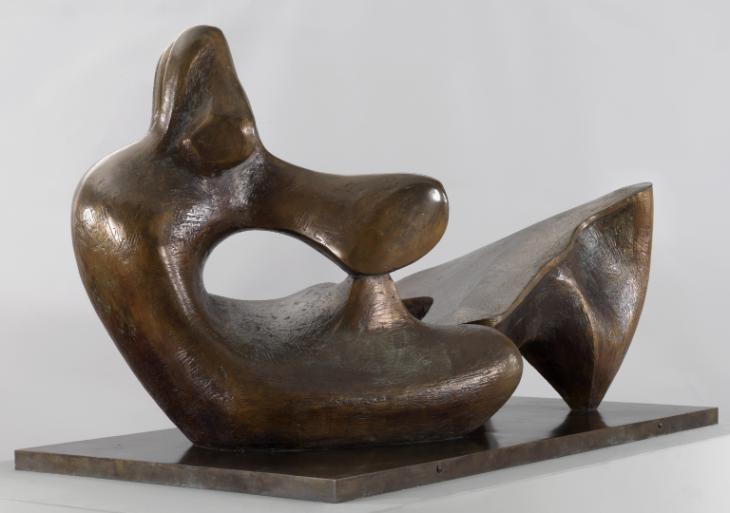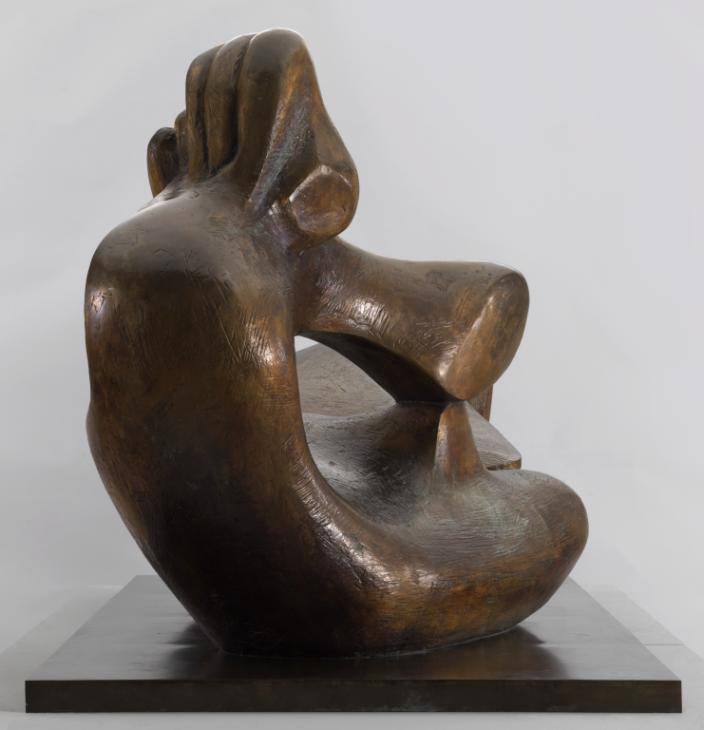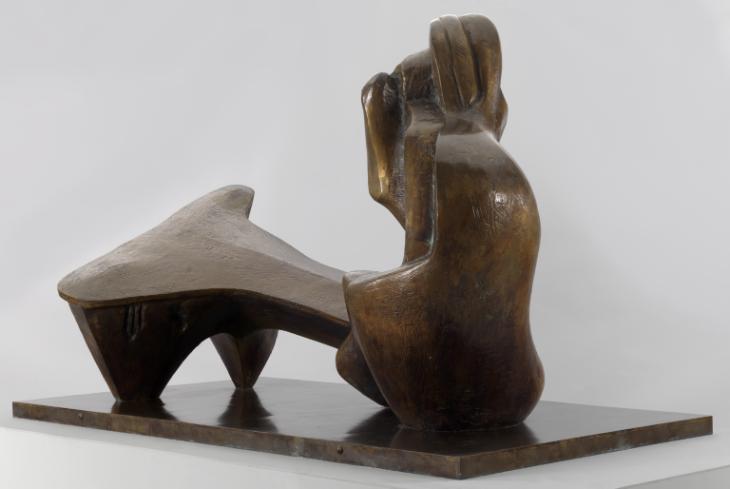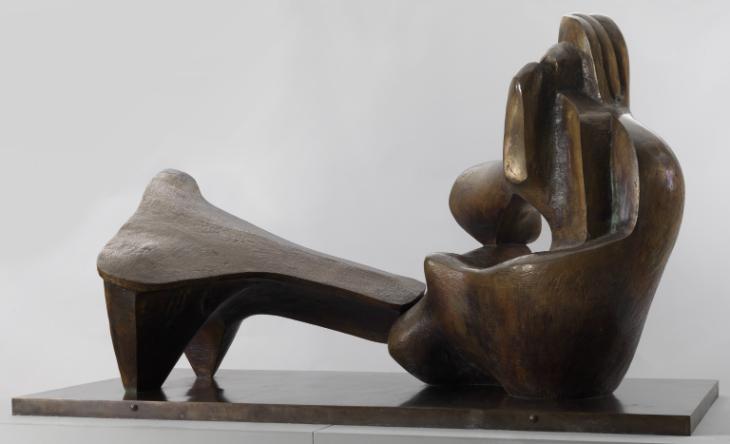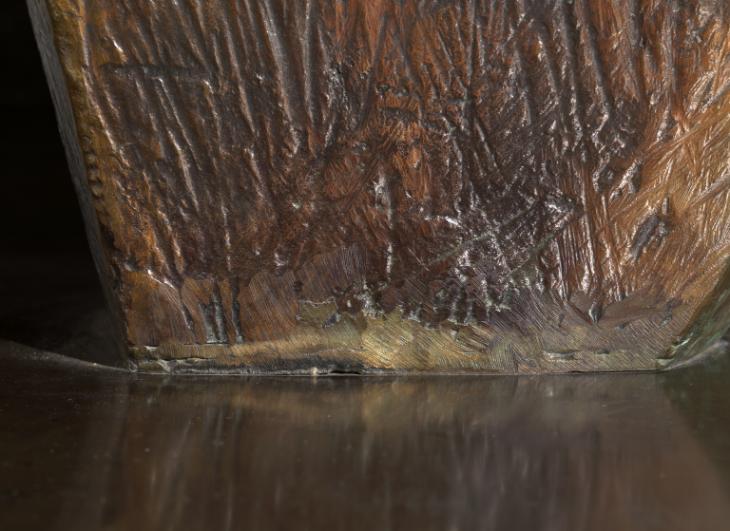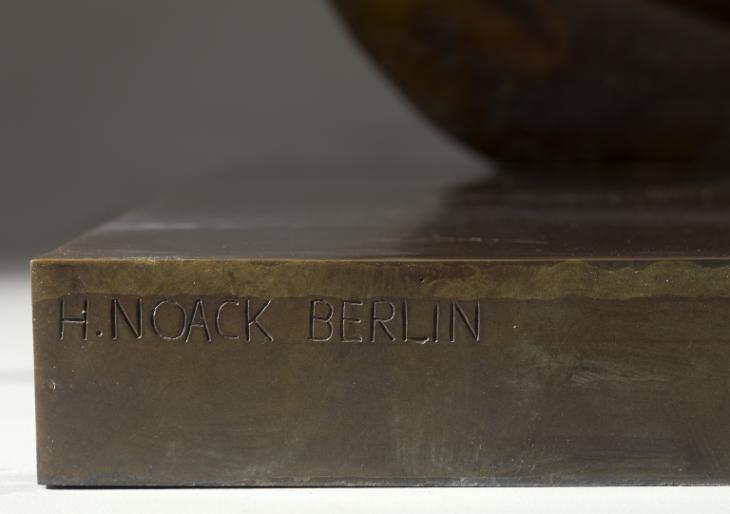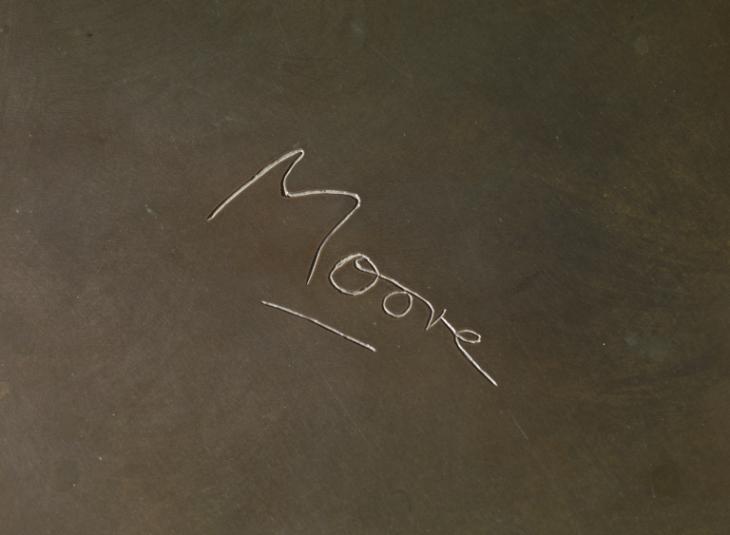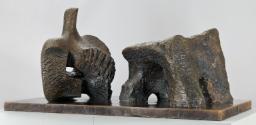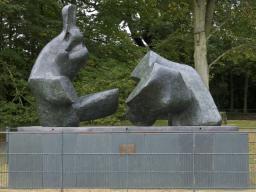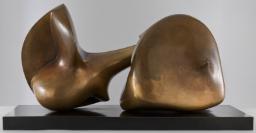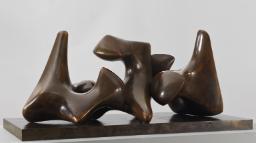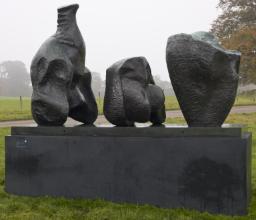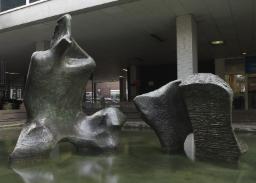Henry Moore OM, CH Two Piece Reclining Figure No.9 1968, cast c.1968-70
Image 1 of 15
-
 Henry Moore OM, CH, Two Piece Reclining Figure No.9 1968, cast c.1968-70© The Henry Moore Foundation. All Rights Reserved© The Henry Moore Foundation. All Rights Reserved
Henry Moore OM, CH, Two Piece Reclining Figure No.9 1968, cast c.1968-70© The Henry Moore Foundation. All Rights Reserved© The Henry Moore Foundation. All Rights Reserved -
 Henry Moore OM, CH, Two Piece Reclining Figure No.9 1968, cast c.1968-70© The Henry Moore Foundation. All Rights Reserved© The Henry Moore Foundation. All Rights Reserved
Henry Moore OM, CH, Two Piece Reclining Figure No.9 1968, cast c.1968-70© The Henry Moore Foundation. All Rights Reserved© The Henry Moore Foundation. All Rights Reserved -
 Henry Moore OM, CH, Two Piece Reclining Figure No.9 1968, cast c.1968-70© The Henry Moore Foundation. All Rights Reserved© The Henry Moore Foundation. All Rights Reserved
Henry Moore OM, CH, Two Piece Reclining Figure No.9 1968, cast c.1968-70© The Henry Moore Foundation. All Rights Reserved© The Henry Moore Foundation. All Rights Reserved -
 Henry Moore OM, CH, Two Piece Reclining Figure No.9 1968, cast c.1968-70© The Henry Moore Foundation. All Rights Reserved© The Henry Moore Foundation. All Rights Reserved
Henry Moore OM, CH, Two Piece Reclining Figure No.9 1968, cast c.1968-70© The Henry Moore Foundation. All Rights Reserved© The Henry Moore Foundation. All Rights Reserved -
 Henry Moore OM, CH, Two Piece Reclining Figure No.9 1968, cast c.1968-70© The Henry Moore Foundation. All Rights Reserved© The Henry Moore Foundation. All Rights Reserved
Henry Moore OM, CH, Two Piece Reclining Figure No.9 1968, cast c.1968-70© The Henry Moore Foundation. All Rights Reserved© The Henry Moore Foundation. All Rights Reserved -
 Henry Moore OM, CH, Two Piece Reclining Figure No.9 1968, cast c.1968-70© The Henry Moore Foundation. All Rights Reserved© The Henry Moore Foundation. All Rights Reserved
Henry Moore OM, CH, Two Piece Reclining Figure No.9 1968, cast c.1968-70© The Henry Moore Foundation. All Rights Reserved© The Henry Moore Foundation. All Rights Reserved -
 Henry Moore OM, CH, Two Piece Reclining Figure No.9 1968, cast c.1968-70© The Henry Moore Foundation. All Rights Reserved© The Henry Moore Foundation. All Rights Reserved
Henry Moore OM, CH, Two Piece Reclining Figure No.9 1968, cast c.1968-70© The Henry Moore Foundation. All Rights Reserved© The Henry Moore Foundation. All Rights Reserved -
 Henry Moore OM, CH, Two Piece Reclining Figure No.9 1968, cast c.1968-70© The Henry Moore Foundation. All Rights Reserved© The Henry Moore Foundation. All Rights Reserved
Henry Moore OM, CH, Two Piece Reclining Figure No.9 1968, cast c.1968-70© The Henry Moore Foundation. All Rights Reserved© The Henry Moore Foundation. All Rights Reserved -
 Henry Moore OM, CH, Two Piece Reclining Figure No.9 1968, cast c.1968-70© The Henry Moore Foundation. All Rights Reserved© The Henry Moore Foundation. All Rights Reserved
Henry Moore OM, CH, Two Piece Reclining Figure No.9 1968, cast c.1968-70© The Henry Moore Foundation. All Rights Reserved© The Henry Moore Foundation. All Rights Reserved -
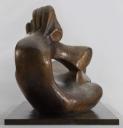 Henry Moore OM, CH, Two Piece Reclining Figure No.9 1968, cast c.1968-70© The Henry Moore Foundation. All Rights Reserved© The Henry Moore Foundation. All Rights Reserved
Henry Moore OM, CH, Two Piece Reclining Figure No.9 1968, cast c.1968-70© The Henry Moore Foundation. All Rights Reserved© The Henry Moore Foundation. All Rights Reserved -
 Henry Moore OM, CH, Two Piece Reclining Figure No.9 1968, cast c.1968-70© The Henry Moore Foundation. All Rights Reserved© The Henry Moore Foundation. All Rights Reserved
Henry Moore OM, CH, Two Piece Reclining Figure No.9 1968, cast c.1968-70© The Henry Moore Foundation. All Rights Reserved© The Henry Moore Foundation. All Rights Reserved -
 Henry Moore OM, CH, Two Piece Reclining Figure No.9 1968, cast c.1968-70© The Henry Moore Foundation. All Rights Reserved© The Henry Moore Foundation. All Rights Reserved
Henry Moore OM, CH, Two Piece Reclining Figure No.9 1968, cast c.1968-70© The Henry Moore Foundation. All Rights Reserved© The Henry Moore Foundation. All Rights Reserved -
 Henry Moore OM, CH, Two Piece Reclining Figure No.9 1968, cast c.1968-70© The Henry Moore Foundation. All Rights Reserved© The Henry Moore Foundation. All Rights Reserved
Henry Moore OM, CH, Two Piece Reclining Figure No.9 1968, cast c.1968-70© The Henry Moore Foundation. All Rights Reserved© The Henry Moore Foundation. All Rights Reserved -
 Henry Moore OM, CH, Two Piece Reclining Figure No.9 1968, cast c.1968-70© The Henry Moore Foundation. All Rights Reserved© The Henry Moore Foundation. All Rights Reserved
Henry Moore OM, CH, Two Piece Reclining Figure No.9 1968, cast c.1968-70© The Henry Moore Foundation. All Rights Reserved© The Henry Moore Foundation. All Rights Reserved -
 Henry Moore OM, CH, Two Piece Reclining Figure No.9 1968, cast c.1968-70© The Henry Moore Foundation. All Rights Reserved© The Henry Moore Foundation. All Rights Reserved
Henry Moore OM, CH, Two Piece Reclining Figure No.9 1968, cast c.1968-70© The Henry Moore Foundation. All Rights Reserved© The Henry Moore Foundation. All Rights Reserved
© The Henry Moore Foundation. All Rights Reserved
Henry Moore OM, CH,
Two Piece Reclining Figure No.9
1968, cast c.1968-70
© The Henry Moore Foundation. All Rights Reserved
This large bronze sculpture is the ninth in a series of two-piece reclining figures that Moore began in 1959 and developed throughout the 1960s. The fact that the two components of this sculpture actually touch distinguishes it from the earlier works in the series, as does its more abstract appearance.
Henry Moore OM, CH 1898–1986
Two Piece Reclining Figure No.9
1968, cast c.1968–70
Bronze
1435 x 2438 x 1350 mm
Inscribed ‘Moore’ on base and stamped with foundry mark ‘H. NOACK BERLIN’ on side of base
Presented by the artist 1978
Artist’s copy aside from edition of 7
T02301
Two Piece Reclining Figure No.9
1968, cast c.1968–70
Bronze
1435 x 2438 x 1350 mm
Inscribed ‘Moore’ on base and stamped with foundry mark ‘H. NOACK BERLIN’ on side of base
Presented by the artist 1978
Artist’s copy aside from edition of 7
T02301
Ownership history
Presented by the artist to Tate in 1978 as part of the Henry Moore Gift.
Exhibition history
1968
Henry Moore, Rijksmuseum Kröller-Müller, Otterlo, May–July 1968; Museum Boymans-Van Beuningen, Rotterdam, September–November 1968, no.124.
1970
Henry Moore: Bronzes 1961–70, Marlborough Gallery, New York, April–May 1970, no.28.
1971
Henry Moore 1961–1971, Staatsgalerie Moderner Kunst, Munich, October–November 1971, no.25.
1978
The Henry Moore Gift, Tate Gallery, London, June–August 1978, no number.
1983
Henry Moore: Winchester 1983, Winchester Castle, Winchester, July–September 1983, no number.
References
1968
Henry Moore, exhibition catalogue, Rijksmuseum Kröller-Müller, Otterlo 1968, reproduced.
1968
Henry Moore, exhibition catalogue, Marlborough Fine Art, London 1968, reproduced.
1970
Henry Moore: Bronzes 1961–70, exhibition catalogue, Marlborough Gallery, New York 1970, reproduced pp.66–7.
1971
Henry Moore 1961–1971, exhibition catalogue, Staatsgalerie Moderner Kunst, Munich 1971, reproduced pp.30–1.
1973
Henry J. Seldis, Henry Moore in America, New York 1973 (another cast reproduced p.192).
1977
Alan Bowness (ed.), Henry Moore. Volume 4: Complete Sculpture 1964–73, London 1977, no.576, reproduced pls.82–5.
1978
The Henry Moore Gift, exhibition catalogue, Tate Gallery, London 1978, reproduced p.60 (two views).
1979
Alan G. Wilkinson, The Moore Collection in the Art Gallery of Ontario, Toronto 1979, p.201 (original plaster reproduced pl.179).
1982
Important Sculptures by Henry Moore, exhibition catalogue, Marlborough Gallery, New York 1982 (another cast reproduced p.9).
1987
Alan G. Wilkinson, Henry Moore Remembered: The Collection at the Art Gallery of Ontario in Toronto, Toronto 1987, p.230 (plaster original reproduced).
2001
Dorothy Kosinski (ed.), Henry Moore: Sculpting the 20th Century, exhibition catalogue, Dallas Museum of Art, Dallas 2001 (another cast reproduced p.229).
2011
Anita Feldman and Malcolm Woodward, Henry Moore: Plasters, London 2011, p.120 (plaster original reproduced).
Technique and condition
This is a large, two-part bronze sculpture of a reclining figure positioned a rectangular bronze base. Moore made the original model for this sculpture by building up successive layers of wet plaster over a supportive armature, probably made from wood and metal (fig.1). The surface of the bronze is deeply striated, although the high points are smooth, indicating that Moore used a variety of different tools to texture the plaster model.
A mould was taken from the completed plaster so that it could be used to make a hollow cast in bronze. Large sculptures such as this were cast in sections at a professional foundry and then assembled by welding them together to form the whole. The welds have been carefully filed down and textured to match the surrounding surface using a range of small punch tools. This process is known as ‘chasing’. However, some seam lines have become visible on the top of the sculpture where the bronze used for the weld, which has a slightly different composition from the rest of the sculpture, has oxidised a different colour. After casting, the surface of the bronze was cleaned but there was no further finishing. While there is little evidence to indicate which technique was used to cast the sculpture, the level of detail on the surface suggests that it may have been made using the lost wax method.
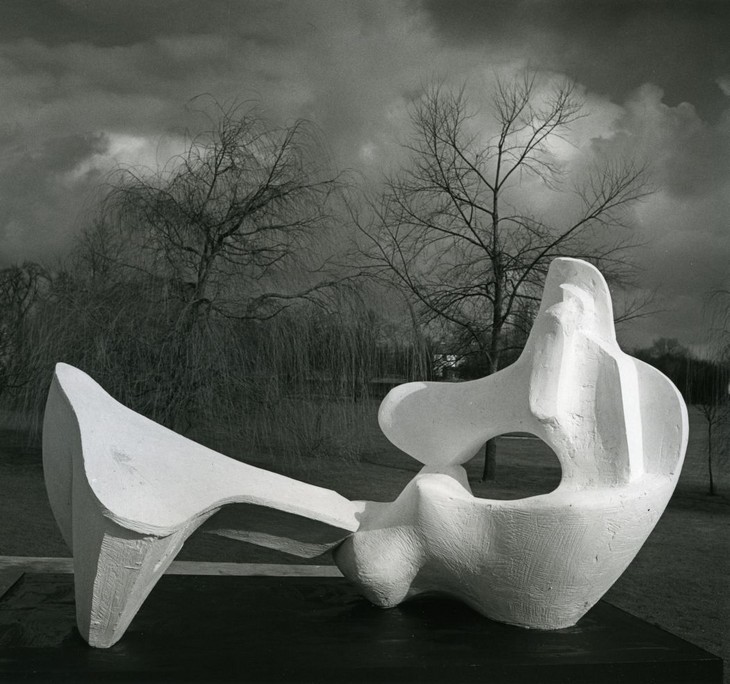
Full-size plaster version of Two Piece Reclining Figure No.9 in Moore's garden at Hoglands 1968
The Henry Moore Foundation
© The Henry Moore Foundation. All Rights Reserved
Fig.1
Full-size plaster version of Two Piece Reclining Figure No.9 in Moore's garden at Hoglands 1968
The Henry Moore Foundation
© The Henry Moore Foundation. All Rights Reserved
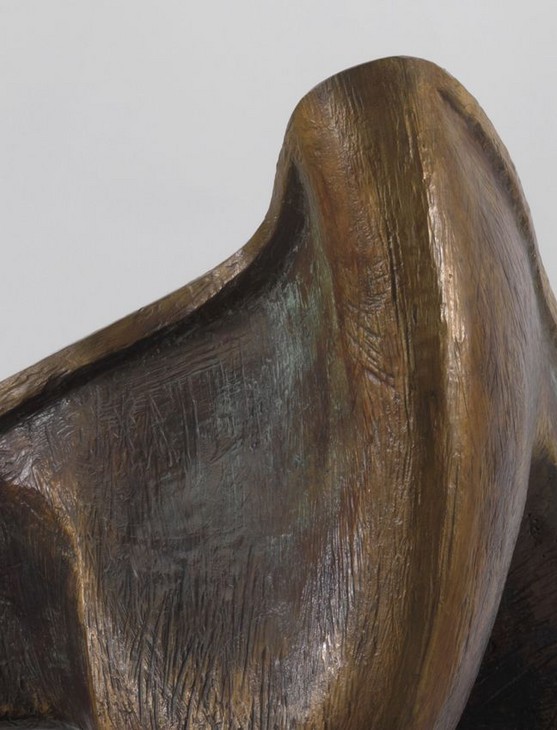
Detail of patina on Two Piece Reclining Figure No.9 1968, cast c.1968–70
Tate T02301
© The Henry Moore Foundation. All Rights Reserved
Fig.2
Detail of patina on Two Piece Reclining Figure No.9 1968, cast c.1968–70
Tate T02301
© The Henry Moore Foundation. All Rights Reserved
The finished bronze sculpture was artificially patinated to colour the surface and help disguise welds and repairs. This process involved applying chemical solutions to the bronze that reacted with the metal to create coloured compounds. In this case the patina is a dark variegated brown with warm and cool shades, while there is a green patina in some of the crevices (fig.2). These different effects were probably achieved by applying at least three different chemical solutions in varying concentrations. There are also some golden highlights on the surface, which may point to the remains of a protective lacquer, applied to prevent the patina from oxidising.
The individual parts of the sculpture are fixed with threaded bolts from underneath the base: two at the end denoting the head and two at the end denoting the feet. On either side of the base there are two large conical headed bronze slotted screws. When these are removed they reveal holes designed to accommodate specialist eye bolts, to which straps or chains can be attached so that the sculpture can be lifted safely into position.

Detail of artist's signature on base of Two Piece Reclining Figure No.9 1968, cast c.1968–70
Tate T02301
© The Henry Moore Foundation. All Rights Reserved
Fig.3
Detail of artist's signature on base of Two Piece Reclining Figure No.9 1968, cast c.1968–70
Tate T02301
© The Henry Moore Foundation. All Rights Reserved
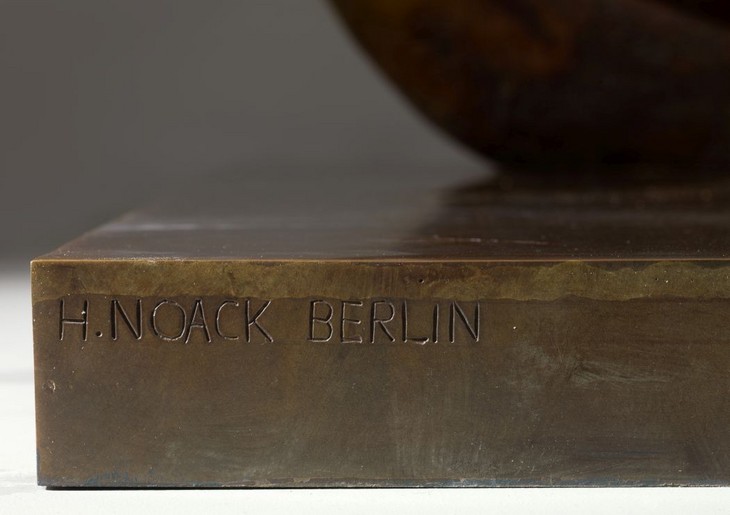
Detail of foundry stamp on base of Two Piece Reclining Figure No.9 1968, cast c.1968–70
Tate T02301
© The Henry Moore Foundation. All Rights Reserved
Fig.4
Detail of foundry stamp on base of Two Piece Reclining Figure No.9 1968, cast c.1968–70
Tate T02301
© The Henry Moore Foundation. All Rights Reserved
The artist’s signature ‘Moore’ is inscribed on the top of the base in a corner (fig.3) while the foundry mark ‘H. NOACK BERLIN’ is inscribed on the side directly below the signature (fig.4).
Lyndsey Morgan
March 2013
How to cite
Lyndsey Morgan, 'Technique and Condition', March 2013, in Alice Correia, ‘Two Piece Reclining Figure No.9 1968, cast c.1968–70 by Henry Moore OM, CH’, catalogue entry, February 2014, in Henry Moore: Sculptural Process and Public Identity, Tate Research Publication, 2015, https://wwwEntry
Two Piece Reclining Figure No.9 was made in 1968 and comprises two bronze forms positioned on a bronze base that together may be understood to represent a reclining human figure (fig.1). The tallest section appears to represent the head and torso, while the longer, horizontal piece denotes the legs. Although the gender of the figure is unspecified, Moore’s large-scale reclining figures are usually regarded as female.

Henry Moore
Two Piece Reclining Figure No.9 1968, cast c.1968–70
Tate T02301
© The Henry Moore Foundation. All Rights Reserved
Fig.1
Henry Moore
Two Piece Reclining Figure No.9 1968, cast c.1968–70
Tate T02301
© The Henry Moore Foundation. All Rights Reserved

Henry Moore
Two Piece Reclining Figure No.9 1968, cast c.1968–70 (side view of torso)
Tate T02301
© The Henry Moore Foundation. All Rights Reserved
Fig.2
Henry Moore
Two Piece Reclining Figure No.9 1968, cast c.1968–70 (side view of torso)
Tate T02301
© The Henry Moore Foundation. All Rights Reserved
The head of the figure does not possess any naturalistic facial features but can be recognised due to its position within the composition. Block-like protrusions with defined edges project out from the front of the neck and chest, while two deep grooves running vertically from the crown of the head and down the back of the figure’s neck are suggestive of flowing hair (fig.2). The main body of the figure curves down from the figure’s left shoulder towards the base, where it bends into a voluminous slab of bronze that may be understood either as an arm or the lower abdomen. From the figure’s right shoulder extends a tubular form that projects outwards horizontally and more closely resembles an arm. This terminates at a large rounded form similar to a hip bone that rises up from the lower abdomen below. The meeting of these two end points creates an enclosed hollow in the centre of the body.
The leg piece is made up of two differently sized vertical trunks, which stand side by side separated by a shallow arch (fig.3), and a longer almost horizontal appendage that bridges the gap between the legs and the body, to which it connects at its tip (fig.4). The two vertical legs of this section both narrow towards the base, while its smooth upper edge slants diagonally.
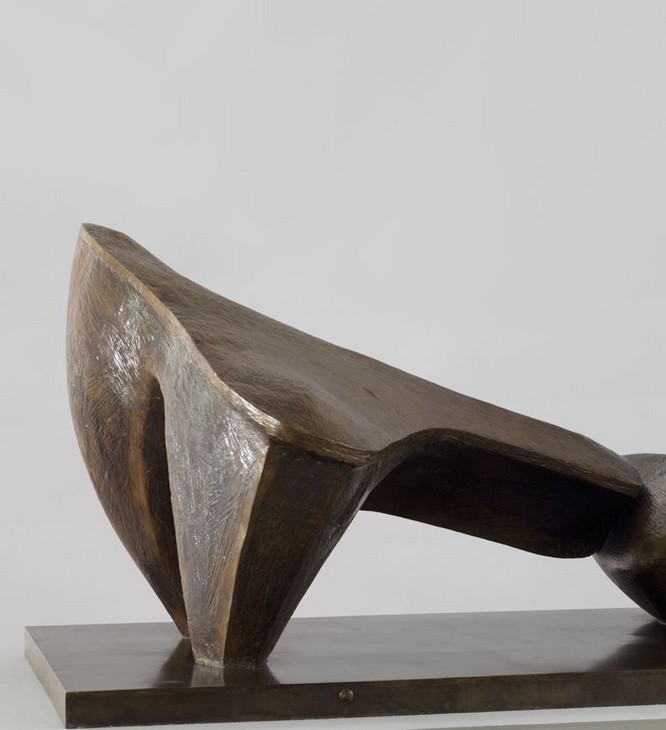
Detail of legs of Two Piece Reclining Figure No.9 1968, cast c.1968–70
Tate T02301
© The Henry Moore Foundation. All Rights Reserved
Fig.3
Detail of legs of Two Piece Reclining Figure No.9 1968, cast c.1968–70
Tate T02301
© The Henry Moore Foundation. All Rights Reserved

Detail of leg section touching the torso section of Two Piece Reclining Figure No.9 1968, cast c.1968–70
Tate T02301
© The Henry Moore Foundation. All Rights Reserved
Fig.4
Detail of leg section touching the torso section of Two Piece Reclining Figure No.9 1968, cast c.1968–70
Tate T02301
© The Henry Moore Foundation. All Rights Reserved
The arrangement of the two parts of this sculpture is significantly different from Moore’s earlier two-piece reclining figures, in which each element is placed apart from the other so that they do not touch. While in his earlier sculptures Moore sought to emphasise the gap between each part, creating an active space between them, in Two Piece Reclining Figure No.9 the two components lock together to form a single entity, albeit one made of two distinctly individual parts.
From plaster to bronze
By the 1960s Moore had established a practice of testing out his designs for sculptures by making small three-dimensional models as opposed to drawing his ideas on a page. In 1978 he explained:
I have gradually changed from using preliminary drawings for my sculptures to working from the beginning in three-dimensions. That is, I first make a maquette for any idea I have for a sculpture. The maquette is only three or four inches in size, and I can hold it in my hand, turning it over to look at it from above, underneath, and in fact from any angle.1
Moore most likely made the plaster sketch-model for Two Piece Reclining Figure No.9 (fig.5) in his maquette studio in the grounds of his home, Hoglands, at Perry Green in Hertfordshire. This studio housed his ever growing collection of found objects, including bones, shells and flint stones, the shapes of which often served as starting points for Moore’s formal experiments in three dimensions. In 1963 Moore explained to the critic David Sylvester how he worked with these objects:
I look at them, handle them, see them from all round, and I may press them into clay and pour plaster into that clay and get a start as a bit of plaster, which is a reproduction of the object. And then add to it, change it. In that sort of way something turns out in the end that you could never have thought of the day before.2
Although Moore’s account of his working methods suggests that a maquette could be made in a single day, it was more usual for an idea to develop over a period of weeks or months. The process of making a plaster reproduction of a bone or pebble took time, for it was only after the plaster had dried that Moore could add and subtract forms, and smooth or sharpen edges and points. Indeed, Moore kept numerous plaster fragments in his studio so that he would always have several ideas in various stages of development, as a photograph from c.1967–8 reveals (fig.6). In 1963 Moore stated, ‘You put it on one side and then in the studio something you did a fortnight previously catches your eye and you know straight away what is wrong with it and you make that alteration, and out of it comes something that you are satisfied with or not’.3 By adding shapes and making adjustments to his plasters Moore was able to make numerous maquettes for two-piece sculptures between 1959 and 1968, although not all of them were scaled up into full-size works, as he admitted towards the end of his career: ‘sometimes I make ten or twenty maquettes for every one that I use in a large scale – the others may get rejected’.4

Henry Moore
Maquette for Two Piece Reclining Figure No.9 1967
Plaster
© The Henry Moore Foundation. All Rights Reserved
Photo: Lyndsey Morgan
Fig.5
Henry Moore
Maquette for Two Piece Reclining Figure No.9 1967
© The Henry Moore Foundation. All Rights Reserved
Photo: Lyndsey Morgan
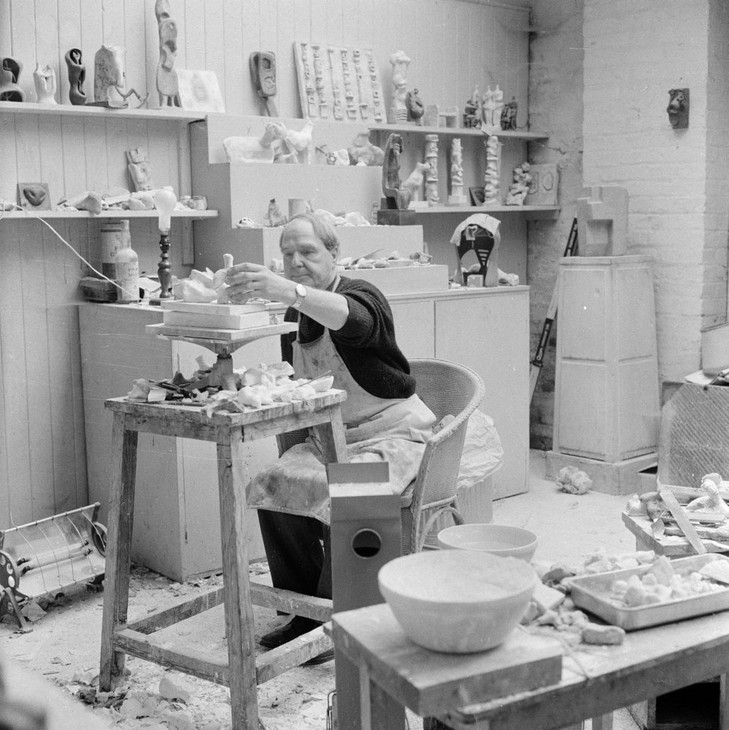
Henry Moore working in his studio c.1967–8
© The Henry Moore Foundation. All Rights Reserved
Photo: John Hedgecoe
Fig.6
Henry Moore working in his studio c.1967–8
© The Henry Moore Foundation. All Rights Reserved
Photo: John Hedgecoe
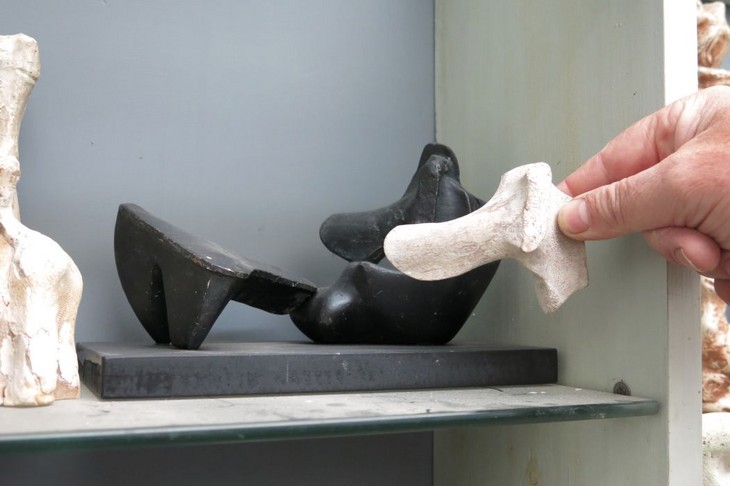
Maquette for Two Piece Reclining Figure No.9 1967 alongside bone fragment
© The Henry Moore Foundation. All Rights Reserved
Photo: Lyndsey Morgan
Fig.7
Maquette for Two Piece Reclining Figure No.9 1967 alongside bone fragment
© The Henry Moore Foundation. All Rights Reserved
Photo: Lyndsey Morgan
After completing the maquette Moore would then have used it as the template for Tate’s larger-scale work. By charting and measuring specific points on the surface of the maquette it was possible to make an exact enlargement of the sculpture. Much, if not all of this work would have been undertaken by Moore’s studio assistants, who in 1968 included Colin Barker, John Farnham, Ramy Shuklinsky and Yeheskiel Yardini
In order to make the full-size plaster from which Tate’s bronze was eventually cast, Moore and his assistants would have initially constructed an armature to the required size and shape for each section of the sculpture. The armature was made up of numerous lengths of wood and possibly chicken wire, and then draped in scrim, a bandage like fabric. Moore’s assistants would then have built up layers of plaster over the armature and scrim until only a short section of each armature rod was exposed. The armature did not only serve a structural purpose; the end of each rod corresponded to a point on the surface of the sculpture as measured and multiplied from the maquette. Moore explained that ‘once they [the assistants] have brought the work within an inch or so of the measurements I intend it to be, I take it over, and then it becomes a thing I’m working on as it would if I had brought it to that stage myself’.6 During the final stage of working on the plaster Moore began to work into the surface of the sculpture. Different marks and textures could be achieved depending on the varying wetness of the plaster as it dried. Moore found plaster to be a very useful material because it could be ‘both built up, as in modeling, or cut down, in the way you carve stone or wood’.7
The surface texture of the plaster was captured in the casting process and an examination of the bronze surface of Two Piece Reclining Figure No.9 shows that Moore developed a range of textures by using a number of different tools. Fine lines mark the leg section of the sculpture (fig.8) while parts of the upper body have a smoother, polished finish.
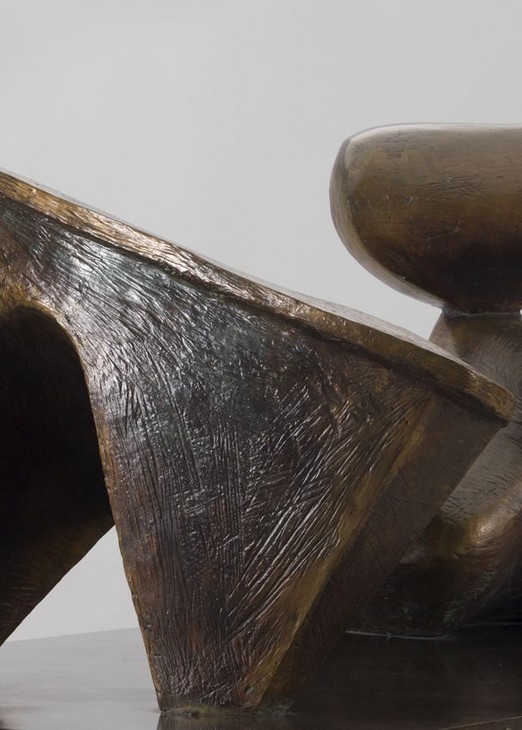
Detail of surface texture of Two Piece Reclining Figure No.9 1968, cast c.1968–70
Tate T02301
© The Henry Moore Foundation. All Rights Reserved
Fig.8
Detail of surface texture of Two Piece Reclining Figure No.9 1968, cast c.1968–70
Tate T02301
© The Henry Moore Foundation. All Rights Reserved

Full-size, coloured plaster version of Two Piece Reclining Figure No.9 in Moore's garden at Hoglands 1968
© The Henry Moore Foundation. All Rights Reserved
Fig.9
Full-size, coloured plaster version of Two Piece Reclining Figure No.9 in Moore's garden at Hoglands 1968
© The Henry Moore Foundation. All Rights Reserved
Moore applied colour to the surface of the full-size plaster when it was complete (fig.9) because, as he explained to the critic David Sylvester in 1963, the reflective qualities of white plaster could lend the sculpture an appearance that would be radically different when cast in bronze.8 Plaster could cast reflected light onto the underside and recessed areas of sculptures, whereas in bronze these areas would appear far darker. Painting the plaster thus allowed Moore to predict the contrast between different areas of the sculpture’s surface before sending it to the foundry.
The finished full-size plaster was sent to the Noack Foundry in West Berlin to be cast in bronze. During the 1950s and early 1960s Moore used a number of different foundries in London and Paris, but started working with Noack in 1958 following an introduction by the dealer Harry Fischer.9 By the 1950s the Noack Foundry was regarded as one of the best foundries equipped to undertake large-scale bronze castings. Moore dealt with its owner Herman Noack directly and paid for the casting of his sculptures himself. In 1967 Moore stated: ‘I use the Noack foundry for casting most of my work because in my opinion, Noack is the best bronze founder I know ... Also, the Noack foundry is reliable in all ways – in keeping to dates of delivery – and in sustaining the quality of their work’.10 There is little evidence to suggest which casting technique was used to create Two Piece Reclining Figure No.9 but the level of surface detail on the sculpture suggests that it was probably cast using the lost wax method.
Two Piece Reclining Figure No.9 was cast in an edition of seven plus one artist’s copy. According to records held at the Henry Moore Foundation, Tate’s cast is number ‘0/7’ indicating that it was the artist’s copy. Although it is unclear when exactly Tate’s example was cast, by 1970 all the other casts in the edition had been sold, suggesting that the complete edition was cast between 1968 and 1970.11
After casting at the foundry the bronze sculpture would have been returned to Moore so that he could check the quality of the casting and make decisions about the patination. A patina is the surface colour of a sculpture and is usually achieved by applying chemical solutions to the pre-heated bronze surface. Publicly, Moore always maintained that he patinated his works himself, and rarely acknowledged that this physical work would have been undertaken by his assistants. It is also known that during the 1960s, as Moore increased his sculptural production and more of his works were editioned, Noack would sometimes patinate his sculptures for him at the foundry. Moore made regular visits to the foundry and could adjust the patina when he felt it necessary. Tate’s cast of Two Piece Reclining Figure No.9 has a variegated brown patina with reddish amber and dark green shades (fig.10).
Origins and development
The subject of the reclining figure had preoccupied Moore for much of his career, and the vertically orientated torso and horizontally orientated legs of Two Piece Reclining Figure No.9 can be seen in previous examples of the subject, including Recumbent Figure 1938 (Tate N05387) and Draped Reclining Woman 1957–8 (Tate T06825). From 1959 and into the 1960s Moore began to systematically divide his reclining figures into two and three pieces, as seen in Two Piece Reclining Figure No.2 1960 (Tate T00395; fig.11). Reflecting on these works in 1962, Moore stated:
The Two-Piece Reclining Figures must have been working around in the back of my mind for years, really. As long ago as 1934 I had done a number of smaller pieces composed of separate forms, two- and three-piece carvings in ironstone, ebony, alabaster and other materials. They were all more abstract than these. I don’t think it was a conscious or intentional thing for me to break up the figures in this way, but I suppose those earlier works from the thirties had something to do with it ... I did the first one in two pieces almost without intending to. But after I’d done it, then the second one became a conscious idea. I realised what an advantage a separated two-piece composition could have ... Once these two parts become separated you don’t expect it to be a naturalistic figure.12
In 1977 the curator Alan Bowness repeated Moore’s observation that the act of breaking up the reclining figure in his two- and three-piece sculptures of the 1960s constituted a return ‘to an idea adumbrated in the 1930s but never developed’.13 One of Moore’s best known sculptures of the 1930s is Four Piece Composition: Reclining Figure 1934 (Tate T02054; fig.12), in which the reclining figure is broken down into four distinct parts spread out across a plinth. In 1968 Moore explained that with this work ‘I began separating forms from each other in order to be able to relate space and form together’.14 Moore similarly focused on this spatial dimension when discussing his two-piece sculptures of the 1960s. Tate curator Richard Morphet recorded that during a conversation held with Moore on 12 December 1980 ‘about both the two- and three-piece reclining figures, Moore was at pains to stress his concern with the interdependence of space and proportion’.15
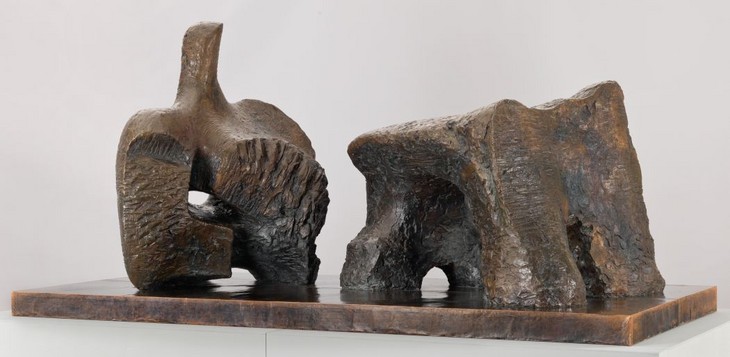
Henry Moore
Two Piece Reclining Figure No.2 1960, cast 1961–2
Tate T00395
© The Henry Moore Foundation. All Rights Reserved
Fig.11
Henry Moore
Two Piece Reclining Figure No.2 1960, cast 1961–2
Tate T00395
© The Henry Moore Foundation. All Rights Reserved
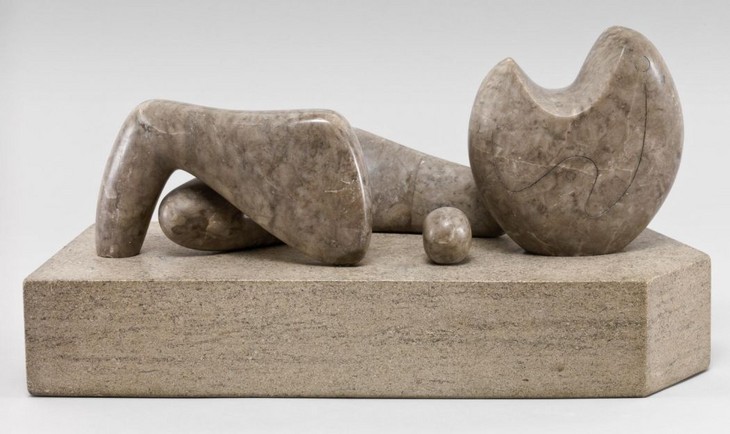
Henry Moore
Four-Piece Composition: Reclining Figure 1934
Cumberland alabaster on a Purbeck marble base
175 x 457 x 203 mm
Tate T02054
© The Henry Moore Foundation. All Rights Reserved
Fig.12
Henry Moore
Four-Piece Composition: Reclining Figure 1934
Tate T02054
© The Henry Moore Foundation. All Rights Reserved
Moore also found that dividing the body into separate components released it from the immediate constraints of naturalistic representation. Two Piece Reclining Figure No.9 is one of Moore’s most abstract treatments of the reclining figure; the leg piece in particular has been reduced and simplified into a table-like form, its scale and shape bearing little resemblance to human legs. In 1986, in an attempt to explain his use of non-naturalistic forms, Moore stated:
People say ‘Art you trying to be abstract?’ thinking then that they know what you are doing through, of course, they don’t understand what the devil it is all about. They think that abstraction means getting away from reality and it often means precisely the opposite – that you are getting close to it, away from a visual interpretation but nearer to an emotional understanding. When I say that I am being abstract, I mean that I am trying to consider but not simply copy nature.16
The arrangement of the sculpture’s two pieces distinguishes Two Piece Reclining Figure No.9 from Moore’s earlier two-piece reclining figures such as Two Piece Reclining Figure No.2. In the earlier sculpture each of the pieces are separate from each other, positioned at a distance in order to emphasise the gap between them. In Two Piece Reclining Figure No.9, however, the leg piece balances against the body section, which, as the curator Alan Wilkinson noted in 1987, relates it closely to the slightly earlier Three Piece Reclining Figure No.2: Bridge Prop 1963 (Tate T02292). Like Bridge Prop, the surfaces of Two Piece Reclining Figure No.9 are predominantly smooth while the balanced non-naturalistic shapes in both works are reminiscent of man-made architectural structures such as suspension bridges. Wilkinson proposed that ‘the strut-like part of the leg end ... rests against the other component of the sculpture like a beam that has been lowered into place’.17
The way in which the two parts of Two Piece Reclining Figure No.9 also bring to mind interlocking bones, specifically shoulder or hip joints. Moore had explored the idea of interlocking joints in Locking Piece 1963–4 (Tate T02293) and it is probable that while making this reclining figure he was looking at bone fragments and thinking about how a skeleton is a singular structure made up of multiple interlocking units.
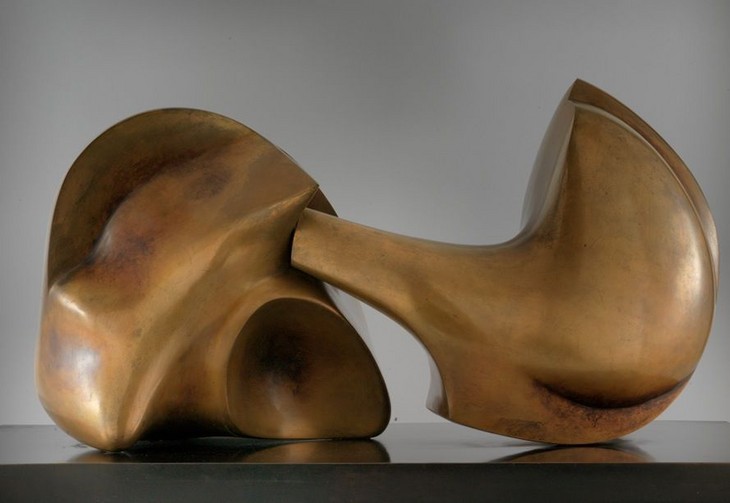 In 1968 the critic and curator David Sylvester identified ‘fitting together’ as a thematic preoccupation in Moore’s work of the later 1960s. Whether touching, resting, clasping or wrapping, Sylvester suggested that ‘penetration and enclosure are implied ... There is a feeling of movement of one within another, only it is uncertain whether this is of entrance of emergence’.18 In 1977 Bowness expanded on Sylvester’s observations, suggesting that ‘the coming together of two or more parts of a sculpture is perhaps the essence of Moore’s later work, both in form and subject’.19 In Two Piece Reclining Figure No.9 the balanced column of the leg piece is reminiscent of Moore’s earlier work Two Piece Sculpture No.7: Pipe 1966 (Tate T02300; fig.13). According to Bowness, in both sculptures the two pieces touch via an elongated pipe-like component which refers ‘obliquely to the sexual relationship ... [whereby] the pipe is an obviously phallic form’.20
In 1968 the critic and curator David Sylvester identified ‘fitting together’ as a thematic preoccupation in Moore’s work of the later 1960s. Whether touching, resting, clasping or wrapping, Sylvester suggested that ‘penetration and enclosure are implied ... There is a feeling of movement of one within another, only it is uncertain whether this is of entrance of emergence’.18 In 1977 Bowness expanded on Sylvester’s observations, suggesting that ‘the coming together of two or more parts of a sculpture is perhaps the essence of Moore’s later work, both in form and subject’.19 In Two Piece Reclining Figure No.9 the balanced column of the leg piece is reminiscent of Moore’s earlier work Two Piece Sculpture No.7: Pipe 1966 (Tate T02300; fig.13). According to Bowness, in both sculptures the two pieces touch via an elongated pipe-like component which refers ‘obliquely to the sexual relationship ... [whereby] the pipe is an obviously phallic form’.20

Henry Moore
Two Piece Sculpture No.7: Pipe 1966, cast date unknown
Tate T02300
© The Henry Moore Foundation. All Rights Reserved
Fig.13
Henry Moore
Two Piece Sculpture No.7: Pipe 1966, cast date unknown
Tate T02300
© The Henry Moore Foundation. All Rights Reserved
The Henry Moore Gift
Two Piece Reclining Figure No.9 was presented by Henry Moore to the Tate Gallery in 1978 as part of the Henry Moore Gift, which comprised thirty-six sculptures in bronze, marble and plaster. Moore first indicated his plan to give the gallery a large selection of his work in the early 1960s, and in June 1969 a deed of agreement was signed, which outlined the terms of the Gift and the works included in it. It was agreed that the works would remain in Moore’s possession for his lifetime, should he so choose. However, in 1977 Tate’s director Norman Reid petitioned Moore to present his Gift so that it could be displayed in its entirety alongside the Tate’s existing collection of his work in an exhibition celebrating the artist’s eightieth birthday scheduled for the following year. Moore duly agreed and the Gift was delivered to the Tate in June 1978. A press release was prepared announcing that ‘The group [of sculptures] is the most substantial gift of works ever given to the Tate by an artist during his lifetime’.21 Two Piece Reclining Figure No.9 was exhibited in gallery eighteen alongside Working Model for Three Way Piece No.2: Archer 1964 (Tate T02299), Two Piece Sculpture No.7: Pipe 1966 (Tate T02300) and Upright Form Knife Edge 1966 (Tate T01172). The exhibition was attended by over 20,500 people and nearly 11,000 copies of the catalogue were sold.22 At its close in late August the Director of Tate, Norman Reid, reflected in a letter to Moore’s daughter Mary Danowski that although he was sad to see the exhibition come to an end ‘we have the consolation of the splendid group of sculptures which Henry has presented to the nation’.23
The other casts of Two Piece Reclining Figure No.9 are held in the collections of the National Library of Australia, Canberra; Norton Simon Museum, Pasadena; Northpark National Bank, Dallas; The Lynden Sculpture Garden, Milwaukee; Nelson-Atkins Museum of Art, Kansas City; and the Barbro Osher Sculpture Garden at the de Young Museum, San Francisco. The whereabouts of the final bronze is unknown. The full-size plaster from which the bronze edition was cast is held in the collection of the Art Gallery of Ontario, Toronto.
Alice Correia
February 2014
Notes
Henry Moore in ‘Henry Moore Talking to David Sylvester’, 7 June 1963, transcript of Third Programme, BBC Radio, broadcast 14 July 1963, p.18, Tate Archive TGA 200816. (An edited version of this interview was published in the Listener, 29 August 1963, pp.305–7.)
Henry Moore cited in Albert Elsen, ‘Henry Moore’s Reflections on Sculpture’, Art Journal, vol.26, no.4, Summer 1967, p.355.
Henry Moore cited in Donald Hall, ‘Henry Moore: An Interview by Donald Hall’, Horizon, November 1960, reprinted in Alan Wilkinson (ed.), Henry Moore: Writings and Conversations, Aldershot 2002, p.226.
Henry Moore cited in Carlton Lake, ‘Henry Moore’s World’, Atlantic Monthly, vol.209, no.1, January 1962, p.44.
Richard Morphet, ‘T.2287 Two-Piece Reclining Figure No.3’, in The Tate Gallery 1978–80: Illustrated Catalogue of Acquisitions, London 1981, p.130.
Henry Moore cited in John Hedgecoe (ed.), Henry Moore: My Ideas, Inspirtation and Life as an Artist, London 1986, p.87.
Alan G. Wilkinson, Henry Moore Remembered: The Collection at the Art Gallery of Ontario in Toronto, Toronto 1987, p.230.
Related essays
- Scale at Any Size: Henry Moore and Scaling Up Rachel Wells
- 'I tried to push him down the stairs': John Berger and Henry Moore in Parallel Tom Overton
- Henry Moore: The Plasters Anita Feldman
- Erich Neumann on Henry Moore: Public Sculpture and the Collective Unconscious Tim Martin
- Henry Moore's Approach to Bronze Lyndsey Morgan and Rozemarijn van der Molen
Related catalogue entries
How to cite
Alice Correia, ‘Two Piece Reclining Figure No.9 1968, cast c.1968–70 by Henry Moore OM, CH’, catalogue entry, February 2014, in Henry Moore: Sculptural Process and Public Identity, Tate Research Publication, 2015, https://www

